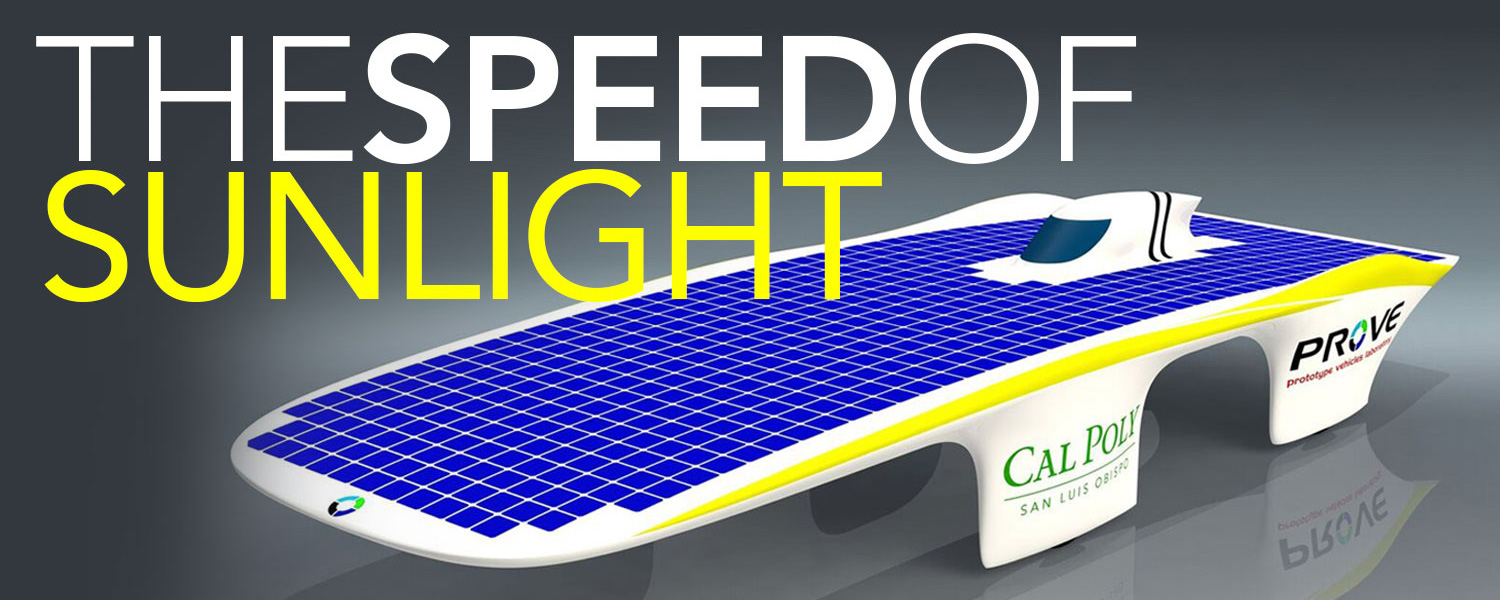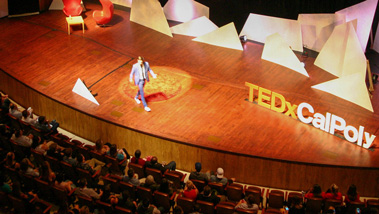
By Larry Peña
Photos by Kaori Funahashi, video by Matt Yoon
It’s 7 p.m. on a weeknight just before Thanksgiving break. In a room in Cal Poly’s Advanced Technology Laboratories (ATL) facility, about 20 students from the group Prototype Vehicles Laboratory (PROVE) are hard at work. They’re comparing notes and calculations in small groups. A few are tinkering with solar cells and 3D printers. Laptops are open on every surface, and on some of these screens students are manipulating the design of a vehicle’s long, thin, wing-like silhouette.
The project has been underway for more than a year, but just a few weeks ago it took on a new level of intensity. That was when this team of Cal Poly students announced to the world, in media outlets as far away as the New York Times, that in a few months they will attempt to break the world record for land speed in a solar-powered vehicle.
“Nothing incentivizes someone to make it happen better than knowing someone will be watching you,” says Will Sutton, a fourth-year aerospace engineering student who is one of the team’s two co-leads. “The more people who know about it, the easier it is to make the project happen.”
 The design that the team has developed looks straight out of science fiction. The PROVE car resembles a long rectangular segment of an airplane wing. The top is wide and flat except for a small bubble to cover the cockpit and allow the driver visibility, maximizing surface area for the array of solar panels. The wheels rest below the outer edges of the vehicle, protected from the front by rounded shields, or fairings. These fairings are configured precisely to allow the rear wheels to draft off of the air channels created by the front wheels.
The design that the team has developed looks straight out of science fiction. The PROVE car resembles a long rectangular segment of an airplane wing. The top is wide and flat except for a small bubble to cover the cockpit and allow the driver visibility, maximizing surface area for the array of solar panels. The wheels rest below the outer edges of the vehicle, protected from the front by rounded shields, or fairings. These fairings are configured precisely to allow the rear wheels to draft off of the air channels created by the front wheels.
“This project is all about finding little ways to reduce drag wherever we can,” says Garrett Klunk, the head of the PROVE team’s aerodynamics group. “For a car that only has 11 pounds of drag at top speed, every bit counts.”
The technology that is going into this car is not cutting edge — PROVE is only using commercially-available solar cells to power the vehicle. The innovation comes from the vehicle’s design and the ability of the students to see the possibilities for how solar power can impact a vehicle’s performance. The end result won’t be a vehicle that consumers could use to commute to work, but rather a model to inspire others to incorporate clean energy more fully into road-ready designs.
“Cars in the future could use solar cells to augment other power systems, maybe even take an electric car to 1,000 miles per charge,” says Clunk. “If a bunch of students can break this record, anyone who is paying attention will see the potential for incorporating solar technology in car design.”
Over the past year, the team has been designing, reviewing and refining the shape of the vehicle, but this winter the physical work of building and assembling it actually begins. PROVE is partnering with a Southern California motor boat company to fabricate the carbon fiber components for the vehicle’s chassis, which will then be shipped back to Cal Poly for assembly.
“That will be a whole new ball game for the project, since it’s all been design and theoretical work up to this point,” says Sutton. “Once we are actually building, there is going to be a whole new sense of excitement in the lab.”
 The moment of truth will come in July, and PROVE actually has their sights set on two current world records. The more prestigious one is held by the FIA, the international governing body for motor sports. The fastest all-solar vehicle clocked by the FIA, built by a team of Dutch engineers, was recorded at about 23 miles per hour. The more ambitious record was noted by Guinness World Records — a Japanese-built solar car that clocked 56.5 miles per hour. Sutton is confident that PROVE can beat them both.
The moment of truth will come in July, and PROVE actually has their sights set on two current world records. The more prestigious one is held by the FIA, the international governing body for motor sports. The fastest all-solar vehicle clocked by the FIA, built by a team of Dutch engineers, was recorded at about 23 miles per hour. The more ambitious record was noted by Guinness World Records — a Japanese-built solar car that clocked 56.5 miles per hour. Sutton is confident that PROVE can beat them both.
“What we are doing is ambitious — it requires a lot of clever design and smart engineering — but we’ve been working at this for a long time,” he says. “It’s an opportunity to showcase something really new and innovative to the world, and I think it characterizes what Cal Poly is supposed to be about.”
Learn more about PROVE and the solar car project at provelab.com
Having trouble viewing the video? Click here.






